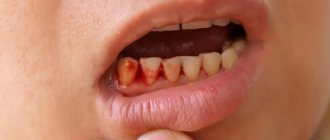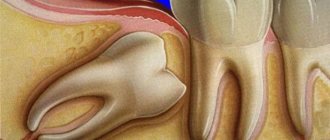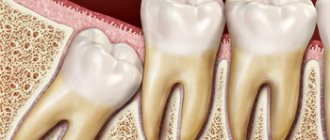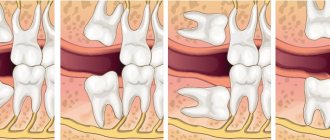Publication date: 10/10/2018
The growth of a wisdom tooth has its own peculiarities - by the time it begins to erupt, the dentition has already formed, and there is no room left for its normal development. Improper eruption is accompanied by inflammatory processes, since an infection can easily get into injured tissues.
As the process progresses deeper, periodontitis may develop. The inflammatory process is accompanied by redness and swelling of the gums, severe pain appears, and an unpleasant odor comes from the mouth. Wisdom loss can cause excruciating pain.
To eliminate toothache, you need to know the cause of its occurrence. This work can only be performed professionally by a specialist in a clinic setting. But before visiting the dentist, the condition can be alleviated a little. There are recipes that will help you independently eliminate inflammation and relieve pain, the source of which is a growing wisdom tooth.
“Eights” appear after 20 years. The pain of this process is due to two reasons:
- Wrong direction of growth;
- Inflammation of the gums due to problematic eruption.
The problem is also related to the fact that there was no milk tooth at the site of its growth, and there was no prepared socket. If the growth of a wisdom tooth is associated with prolonged pain, a visit to the doctor cannot be avoided.
Online consultation with a doctor
If you are worried about your wisdom teeth and have symptoms such as: pain in the “eights”, swelling of the gums around, swelling of the cheek. When chewing or while moving the jaw, smiling, talking, unpleasant sensations and pain appear. It is best to undergo an examination and consultation with a dentist. Because you won’t be able to cure a wisdom tooth on your own or help it erupt at home. And complications arising due to lost time can lead to the necessary more complex and expensive treatment:
- removing the “eight”;
- treatment of infected adjacent teeth;
- prosthetics;
- implantation.
Pain in the gums from wisdom teeth: folk remedies will help
Folk remedies have also proven effective in combating pain during the eruption of the figure eight. To relieve pain you can use:
- Alcohol adjustment of calendula: it will help relieve pain, relieve swelling and stop the growth of bacteria;
- Sage decoction: brew two tablespoons of the herb with 0.5 liters of boiling water, leave, strain and always rinse warm;
- Oak decoctions: pour 6 tablespoons of bark with water (0.5 liters), boil, add sage (4 tablespoons), cool and rinse with a warm solution. This remedy has not only analgesic, but also antiseptic properties;
- Turnip decoction: chop the turnips, add three tablespoons of water, boil and simmer for 15 minutes. Rinse as often as possible;
- Soda and salt: prepare a solution (one spoon of both per glass of water, you can add a drop of iodine) and rinse very often;
- Decoction of calendula or chamomile: pour boiling water over 1 spoon of any of these herbs (you can use two together), leave, strain and immediately rinse;
- Chicory root: boil the decoction (a tablespoon of dry chicory per glass of boiling water) for five minutes, cool and strain, rinse no more than 4-6 times a day;
- Propolis tincture: relieves swelling well, reduces inflammation and kills infection. To do this, you need to dissolve 5-10 drops of tincture in a glass of warm water.
- Clove or sea buckthorn oil: apply to the gums and massage a little.
You can also try using a cold compress to relieve wisdom tooth pain (a warm compress should absolutely not be used if a wisdom tooth is cutting and it hurts to swallow!).
Asepta rinse with chlorhexidine and benzydamine will help relieve pain. It reduces inflammation and disinfects the oral cavity.
Why do wisdom teeth hurt?
Cutting through “eights” without pain is a rare occurrence, so you need to know what to do in such cases.
There are several reasons for pain. The main ones are the following:
- The tooth grows sideways and is incorrectly positioned in relation to other teeth;
- There is no place for it to cut through;
- The tooth grows with caries;
- Poor quality treatment provided;
- The tooth has almost erupted, but is not yet completely visible, as it is covered by the mucous membrane; you should see a doctor to have the hood cut;
- Bacteria and pathogens can accumulate at the site where wisdom teeth erupt.
Rinsing with disinfectants will help. If the tooth grows normally, naturally, then it does not cause any particular trouble. Except for redness and swelling of the gums. Complications from the eruption of the figure eight, as a rule, arise due to a late visit to the dentist for help. If the pain increases and it is not possible to see a doctor, you have to take measures on your own. It should be borne in mind that all home remedies for wisdom tooth pain relief are temporary. You need to seek medical help at the first opportunity.
There are methods that can eliminate or dull pain at home. If the growing wisdom tooth is invisible and there is no discomfort, the ongoing process of eruption can be judged by the following signs:
- The gums and cheek are swollen;
- Body temperature increased slightly;
- Difficulties arise with facial expressions and chewing movements;
- The process of swallowing is associated with painful sensations.
If pain appears at the site where your wisdom tooth erupts, you should see a doctor. In cases where it is not possible to seek help from a dentist, you can use the following tips. There are five effective ways to relieve pain.
Pain and inflammation of the gums above the wisdom tooth -
In this section we will tell you what to do when your wisdom tooth comes out and your gums hurt. As we said above, pain can be associated either with inflammation of the gums above the erupting tooth, or with displacement of the teeth. In the latter case, this is similar to the movement of teeth through the use of braces (only in this case, the movement of teeth will be provoked not by a metal arch, but by an erupting wisdom tooth). The first thing you should do is look into your mouth and assess the situation.
Inflammation of the gums above the wisdom tooth occurs when one part of the crown has already erupted, and the second is still covered with mucous membrane (Fig. 2). That part of the gum mucosa that hangs over the crown of the eighth tooth is what dentists call the “hood.” Food debris and microbial plaque usually accumulate in this place, which leads to inflammation of the mucous membrane and pain.
In addition to pain, the presence of inflammation of the gums above the wisdom tooth is usually indicated by: 1) redness and swelling of the gums, 2) suppuration from under the hood, but sometimes pus can only be released when pressing on it, 3) bad breath, 4) less often may be fever, painful swallowing or difficulty opening the mouth, as well as swelling of the cheek. The presence of symptoms from the last point indicates an unfavorable course of inflammation. Dentists call inflammation of the hood over a wisdom tooth “pericoronitis.”
Eruption of wisdom teeth and “pericoronitis” –
A wisdom tooth is coming out, your gums hurt: what to do if the hood is small and covers only a small part of the crown of the wisdom tooth, and there is no active inflammation (suppuration, painful swallowing, etc.) - antiseptic rinses with Chlorhexidine solution and applications of the anti-inflammatory gel Cholisal can help. In case of severe pain, it is advisable to simultaneously take analgesics from the NSAID group, for example, ibuprofen. These drugs have not only analgesic, but also a pronounced anti-inflammatory effect.
But in all other cases, a minor surgical intervention will be necessary - excision of the hood. The operation is low-traumatic and takes only a few minutes. Its goal is to remove the area of the gum mucosa that hangs over the crown of the tooth. In some cases (when the doctor sees that in any case there is not enough space for the tooth to erupt, which means excision of the hood will only give a temporary effect), the dental surgeon decides to remove the wisdom tooth.
Pericoronitis and laser excision of the hood: video 1-2
Local anti-inflammatory therapy –
- antiseptic rinses with 0.05% Chlorhexidine solution,
- applications with Cholisal-gel.
Treatment of inflamed gums is carried out 2-3 times a day - in the morning after breakfast and brushing your teeth, in the evening (before bed) after brushing your teeth, and also in the middle of the day. Each time, you first need to rinse your mouth with Chlorhexidine for 1 minute - then dry the gums with a dry gauze swab and apply the gel to the surface of the hood using your finger. Afterwards, you should not rinse your mouth or eat food for 2-3 hours. By the way, Cholisal gel, in addition to a pronounced anti-inflammatory effect, also has an analgesic effect.
Expert opinion
Emir Romanovich Omerelli
Maxillofacial surgeon, implantologist
Experience: more than 13 years
Whatever pain relief option you choose, it is important to remember that the absence of pain does not mean the absence of problems. The best option for a person with acute pain is to urgently come to the dental clinic. Moreover, acute pain is a reason for appointment out of turn and without an appointment. Timely correction of the situation - treatment or tooth extraction - will minimize the harm caused to the diseased organ of the oral cavity and the entire body as a whole.
Causes of pain during teething
Pain during the eruption of the eighth tooth is due to several reasons:
- mechanical damage to gum tissue during tooth growth;
- incorrect tooth position;
- lack of space in the oral cavity for its eruption;
- infection under the gum;
- carious damage to the wisdom tooth even before eruption;
- inflammation of the mucous membrane.
It is important to understand that the “eight” is a complex tooth that very often grows incorrectly, has a tangled root system and is sensitive to various inflammations. Therefore, if you experience pain during the eruption of wisdom teeth, it is highly advisable to consult a dentist. The doctor will examine the oral cavity and, if necessary, prescribe pain medications or refer the patient for tooth extraction.
How to relieve the condition yourself
1. You can use pharmaceutical drugs that are available without a prescription:
- Remedies for eliminating inflammation: Ibuprofen and Paracetamol;
- Painkillers: Analgin;
- Gels for gum pain relief: Metrogyl-Denta and Xolisal;
- Antiseptics: Miramistin, Chlorhexidine;
- Maraslavin lotions will relieve swelling and eliminate pain.
2. Decoctions of medicinal herbs. Complications during the eruption of a wisdom tooth are associated with injury to the surrounding gum tissue. Without help, the consequences can be serious. If there is throbbing pain and swelling in the problem area, you should consult a doctor. The danger is that the accumulated pus can quickly spread from the soft tissue of the jaw. Frequent rinsing with a decoction of oak bark, brine, tincture of sage, calendula or chamomile is an effective remedy for relieving swelling and pain relief. You can use a decoction of chicory root.
3. If there is no pharmacy nearby, you can use salt water and soda. It is useful to drop iodine into the solution.
4. Bee products help with dental problems - propolis tincture will relieve swelling, soothe inflamed gum tissue and stop the development of infection.
5. A cold compress will temporarily soothe a sore tooth.
All of the above methods can be used temporarily until you can go to the doctor. It should be remembered that the sooner this meeting occurs, the lower the likelihood of complications.
Remember: it is forbidden to heat the sore spot, as the development of the inflammatory process will only accelerate.
Do you need to rinse your wisdom teeth?
Traditional medicine and modern treatment methods can be combined, including in dentistry. If we consider rinsing a problematic wisdom tooth, then it can only be relevant as a supporting, analgesic and partially disinfecting procedure. It is better for a specialist to decide which remedy will be used after examining the problem area, since in more than 63% of cases the wisdom tooth causes troubles that only a doctor can handle. In these cases, exposure to rinsing solutions can aggravate the situation and provoke the spread of suppuration.
The procedure will definitely not help with incorrect positioning of the tooth, its incomplete exit and other pathologies that require x-rays, specially selected treatment, including antibiotics.
If the process is normal (cutting can last up to 14 days), there is no significant swelling, no unpleasant taste, symbolizing the formation of a purulent focus, it makes sense to choose what to rinse the wisdom tooth with to reduce unpleasant symptoms. It is better to entrust this to a specialist, and at the same time look at how the process is going, whether there is a possibility of the tooth bending, “propping” it into the bone, to exclude all sorts of accompanying phenomena, including periostitis (suppuration due to the formation of gum hoods) and so on.
Complications after removal
Even after removal, a wisdom tooth can cause trouble. The most common complications after a figure eight is pulled out is inflammation. The wound after manipulation remains large and often becomes infected. Suppuration is also possible due to pieces of food getting into the wound. For prevention after tooth extraction, dentists recommend a course of antibiotics. If after removal you feel numbness in the area where the wisdom tooth was, and it does not go away for several days, it means that the doctor has touched and damaged the nerve endings, and must correct the mistake. There is no need to rinse the hole after tooth extraction. Otherwise it will take a long time to heal.
R.S. Do not take the initiative to remove a wisdom tooth. It is unknown how life will turn out. Perhaps one day an eight
It will become the only tooth capable of holding an orthopedic structure and you will be grateful to it.
At the dentist
The main task of the dentist is to alleviate the symptoms that bother you when the figure eight is cutting through, and to decide whether it is necessary to remove it. Is this necessary? As you know, there is nothing superfluous in our body, therefore strict indications are necessary for removing wisdom teeth. This:
- Lack of space for the tooth.
- If the wisdom tooth is cut incorrectly.
- If the tooth is already affected by caries.
- If it interferes with the roots of other teeth.
- If the inflammation caused by the wisdom tooth does not go away.
— If the figure eight chronically injures the buccal mucosa.
— If the dentist cannot cope with the symptoms accompanying teething.
How to help wisdom teeth erupt faster?
The eruption of figure eights is usually accompanied by pain.
Chewing solid food can make the process easier if it does not cause pain.
A soft and careful finger massage has a positive effect.
If your gums hurt and your temperature rises, you should consult a doctor who:
- Determine the cause of pain;
- Heals injured tissues;
- Will alleviate the patient's condition;
- Eliminates an unpleasant phenomenon.
Why does my gum hurt when my wisdom tooth grows?
Atypical growth
When the “figure eight” erupts, it is not the tooth itself that hurts, but the soft tissue surrounding it. This is a reaction to irritation of nerve endings. Most likely, the tooth grows at an angle and rests on the gum, which is why it responds with pain. Sometimes the outer molar lies horizontally and over time begins to injure the “neighbor”: it seems to you that your wisdom tooth hurts, but in fact it is a “seven”.
Pericoronitis
When teething becomes difficult, a gingival hood forms, covering the wisdom tooth. Under this gingival fold, food debris and bacteria get trapped, causing an inflammatory process - pericoronitis. Excruciating aching pain, swelling, redness (hyperemia) appears, and purulent exudate accumulates.
Trigeminal neuralgia
Sometimes a wisdom tooth presses on one of the branches of the facial (trigeminal) nerve, and then severe radiating pain occurs that literally covers half of the face. It seems that your throat, ear or head hurts, but the reason for everything is the ill-fated wisdom tooth.
How wisdom teeth erupt
This process occurs starting from the age of 16 or at a later age. Dentists do not consider the eruption of these teeth to be a deviation even after 40 years.
Over the years, the jaws decrease in size, and there is no room left for the “eights”. If eruption is delayed, an x-ray should be taken to see the reason.
The path of this tooth passes through fairly thick soft tissue, so the following symptoms appear:
- Pain in the problem area or radiating to the jaw;
- Redness;
- Edema;
- Difficulty eating and opening the mouth.
Other manifestations are also possible:
- Second molars suffer from root or cervical caries;
- If the swelling is extensive, the throat and gums may hurt, causing odontogenic sore throat.
What to do if a tooth grows during pregnancy
If a wisdom tooth grows during pregnancy, surgery is contraindicated, as this is a great stress for the child and the expectant mother. In addition, there is a risk of complications, for example, after tooth extraction, the temperature may rise or bleeding from the socket may occur. This must not be allowed!
In this case, it is recommended to use physical therapy or medication to relieve inflammation and pain. You can drink no-shpa or rinse your mouth with chlorhexidine. However, any medications should be used strictly as prescribed by the doctor; the doctor will prescribe medications that do not penetrate the placental barrier.
Possible complications during wisdom tooth growth
What problems await you if you don’t go to the dentist on time?
- Firstly, atypical growth of the figure eight and advanced pericoronitis can lead to deformation of the dentition and malocclusion.
- Secondly, the swelling can be so severe that the proportions of the face are disrupted, and the person cannot open his mouth even a centimeter. Against this background, the submandibular lymph nodes become enlarged and painful.
- Thirdly, any, even the slightest inflammation tends to progress. Bacterial infection and pus penetrate under the gum, affecting the deep periodontal tissues. In rare cases, sepsis (blood poisoning) and death may occur.
At risk are patients with weak immunity, a depleted body after a cold, stress or diet. So don’t put off your visit to the dentist!
More detailed information about excision of the hood of a wisdom tooth is in our article.











